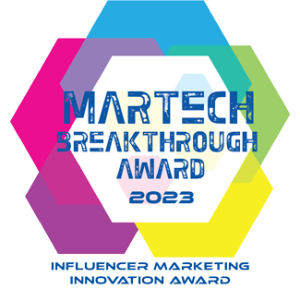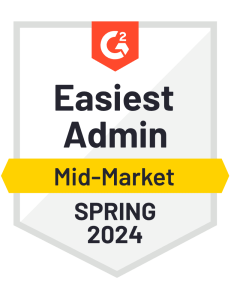Brands often talk about how to create an ideal customer experience (CX) to drive satisfaction and retention. But how do you know what is ideal for your customers? How do you measure success, specifically against contact center industry standards?
Although these questions are common, every company has different standards of success depending on their customer base and their industry. But contact center industry standards can help provide a benchmark for two key areas: response times and agent efficiency contact center metrics.
The benchmarks for the popular contact center metrics below can be used to help set your team goals, but be careful not to use them as a basis for comparing or criticizing. It’s also important to take your customer feedback into consideration to create the right CX strategy for your organization.
Table of contents
Benchmarks for response times expectations by channel
As consumer comfort with digital channels grows, so do their expectations for instantaneous responses to questions. Emplifi research shows 52% of consumers expect to receive a response to their questions within an hour, with 32% expecting to hear back within 30 minutes. Yet about 20% of consumers report that they typically have to wait at least 24 hours to receive a response.

The following sections break down consumer expectations and industry averages for response times across the most popular contact channels.
<div id=”email-response-time”></div>
Email response time
SuperOffice and customer service consultant Jeff Toister conducted a study where they asked 3,200 consumers how quickly they expect brands to respond to their emails. Almost half expect companies to respond in less than 4 hours, with 12% expecting a response within 15 minutes. However, the same study found that 62% of companies do not respond to customer emails at all. This can potentially impact customer satisfaction and loyalty to your brand.

How to improve your email response time: Use a customer case management tool that automates as much of the repetitive agent tasks as possible. For example, Emplifi’s Email Virtual Assistant (EVA) is an email automation solution that can read incoming emails from customers and automatically suggest an email response that agents can review, edit as needed, and send, drastically shortening email response time.
<div id=”social-media-customer-care-response-time”></div>
Social media customer care response time
When it comes to social media channels, consumers often expect quick responses – this holds true regardless of demographics. People are increasingly turning to social media across the customer journey, including 68% currently using (or planning to use) social media to ask questions before making a purchase, and 59% to get post-purchase support.
Here are benchmarks for the three most popular social care channels: Facebook, Instagram, and Twitter.
Facebook
To get the all-important “Very responsive to messages” badge on your Facebook business page, a response time of 15 minutes or less within the past seven days is needed, along with a 90% response rate to private messages.
Instagram
Sixty-three percent of businesses say social selling is a top priority when it comes to ecommerce opportunities. In fact, 70% of all Instagram users make purchases through the app so it is no surprise that consumers expect a response from your brand directly on Instagram. For the best Instagram response time, comments or messages should be resolved within the hour.
Twitter
Customers on Twitter expect a response within 30 minutes and approximately 50% of brands actually meet the 35 minute standard as the general standard for response times on the platform.
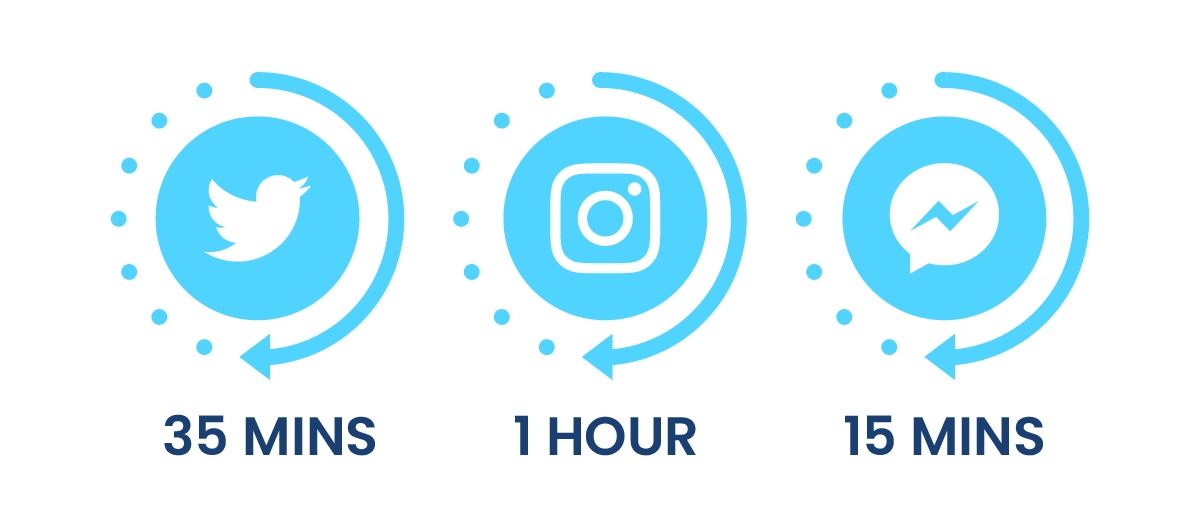
In addition, Emplifi’s research shows the median response times for Facebook, Instagram, and Twitter and how response times differ between each social channel and across various industries. Based on the chart below, It is evident that brands’ response times will need to improve inorder to meet their customers requirements.
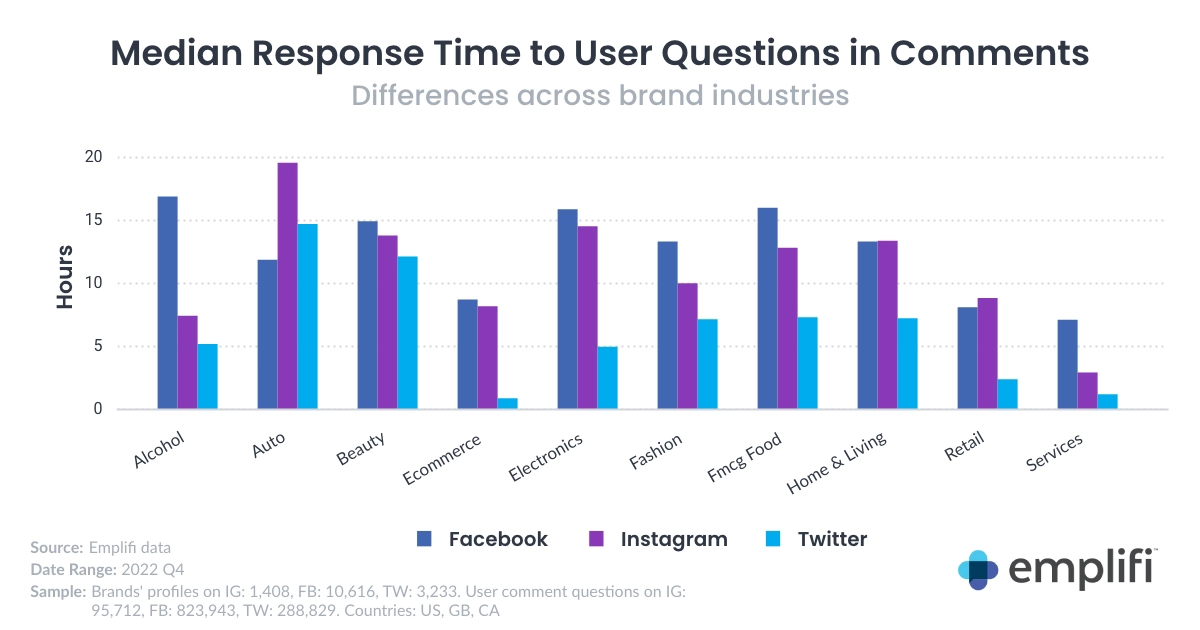
How to improve your social response time: One of the first challenges with social care is accurately identifying which posts are just noise and which posts need your attention. Using a social listening tool can filter through the chaos to surface the urgent, actionable posts, and put them straight into an agent’s case queue for easy follow-up and tracking. You can also speed up response time and deflect cases by deploying a Facebook Messenger chatbot to help customers self-serve.
<div id=”live-chat-response-time”></div>
Live chat response time
Live chat has become a popular contact channel – according to Reply, 73% of buyers prefer live chat and 44% find it very important to have their questions answered by a live chat. In fact, 63% of consumers reported that they are more likely to return to a website that offers live chat.
Live Agent reports that the average live chat wait time is 5 minutes and 57 seconds long in the queue. Once a customer is through to an agent, the average chat duration time is 10 minutes but can vary.
Comm100 reports an 18% jump from 2019 (9 minutes 17 seconds) to 2020 (10 minutes 57 seconds), more than any increase in recent years. The reason being that the COVID-19 pandemic shifted consumers’ expectations of the brands they purchase from. At a time where everything around the world was uncertain yet consumerism was at an all time high, an emphasis on customer experience excellence started to grow. The expectation for ticket resolutions went from an importance placed on speed, and shifted to satisfaction, empathy, and quality service, leading to this increase in chat duration time.
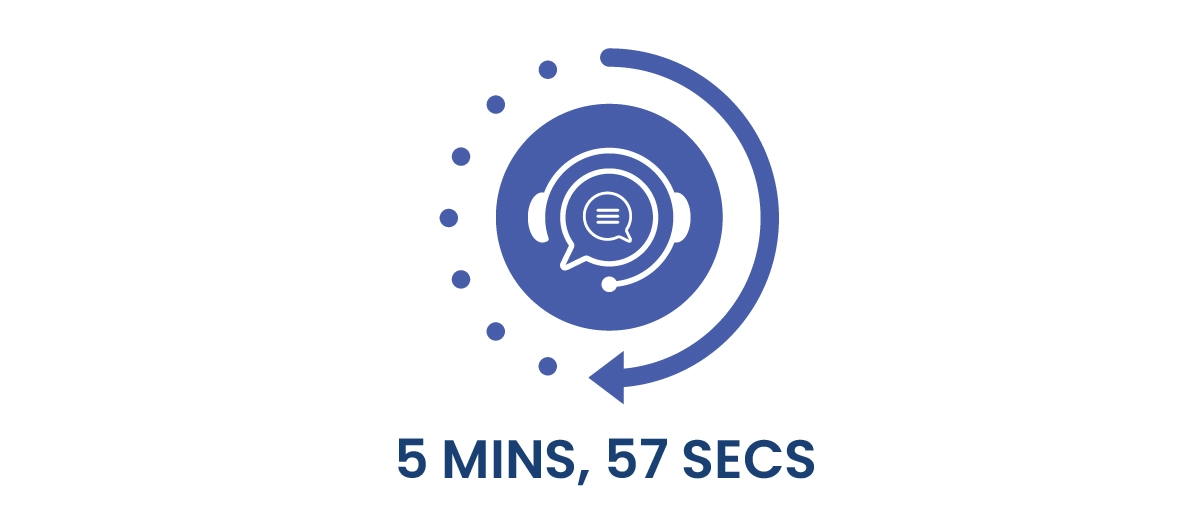
How to improve your live chat response time: A great way to speed up response times across all channels is to enable agents to work all types of cases in a single interface, especially one that is designed to auto-populate all known case information and speed up common data-entry tasks. This enables agents to truly focus on quick, effective interactions. Live chat is another instance where a self-service chatbot can help customers get instant resolutions to a variety of questions and issues without ever needing to involve an agent.
<div id=”texting-sms-response-time”></div>
Texting/SMS response time
SMS holds a lot of promise as a customer service channel as 93% of consumers prefer to communicate with businesses with SMS.
Call Centre Helper Magazine defines the call center industry-standard benchmark for texting response at 80% of messages responded to within 20 seconds. It’s imperative for agents to be able to type at least 80 words per minute and manage 3-5 customers so that brands can follow the best practice of responding to SMS tickets within 1 minute.

How to improve your SMS response time: As with live chat, your best approach for speeding up SMS responses will be to use a chatbot as your first line of defense and consolidate all contact center technologies into one interface for agents. Giving agents in-context guidance and an integrated knowledge base within their case interface can also shorten response time by making answers easy to find in the moment.
<div id=”phone-response-time”></div>
Phone response time
As with the other communication channels we’ve discussed, phone calls are subject to similar expectations for near-instant responses – and that expectation has changed dramatically over the past few years. According to Ozonetel, the average wait time within contact centers is 46 seconds across industries. This means that, before speaking to a company representative, callers waited an average 46 seconds in a call queue.
Similar to texting/SMS, the traditional call center industry standard service level is 80/20, meaning 80% of calls should be answered within 20 seconds. This standard has been used in customer service for the last 30 years, and therefore is not as relevant for a company’s contact center solution. There are many factors that should be taken into account, such as industry, size of business, customer demographic, and much more.
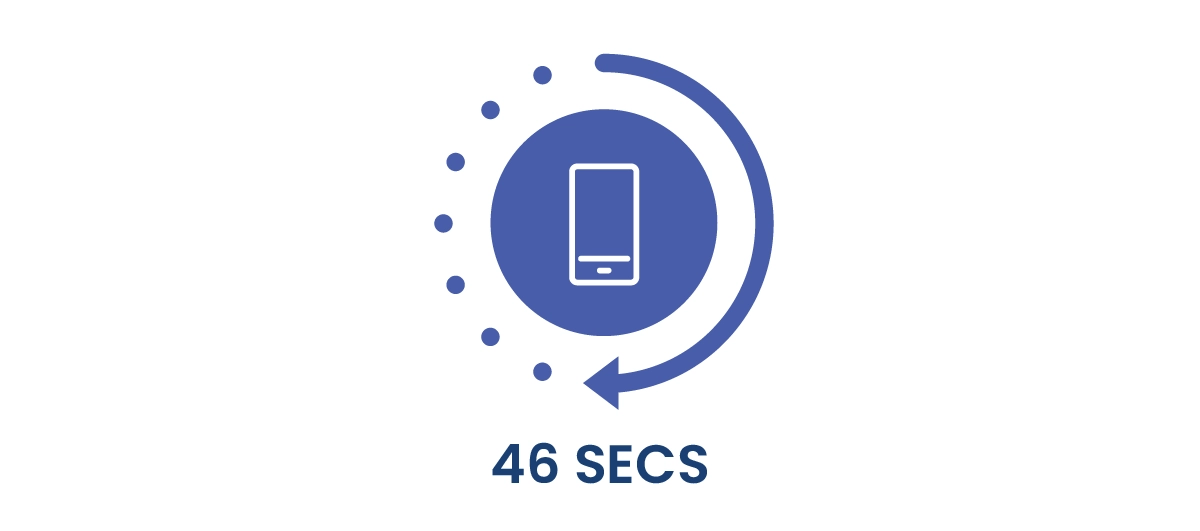
How to improve your phone answer time: Deflecting traffic from ever reaching your 800 number through effective self-service is one of the simplest ways to reduce time to answer. Offloading tier-1 cases to self-service means agents are only working cases that require a human touch. A reduction in overall call volume can allow you to potentially do away with lengthy IVR options, instead of letting customers get directly to a human with no wait time.
Benchmarks for contact center agent efficiency metrics
There is no shortage of contact center metrics that teams use to measure their success, but we have focused on three of the most common metrics for contact center performance.
<div id=”average-handle-time”></div>
Average Handle Time
A 2021 study from TCN shows that 34% of callers are willing to spend an average of 6 minutes on hold before hanging up, and that 26% hang up after spending 2-4 minutes on hold.
Average Handle Time (AHT) can be a misleading metric because shorter resolutions are not inherently more effective ones. AHT should not be measured in a vacuum, but as one part of a larger story about agent efficiency.
In fact, AHT numbers are even more valuable when analyzed in tandem with first contact resolution. Overall, it’s crucial to avoid shortening customer interactions at the expense of effective resolutions and CSAT.
How to improve your AHT: To avoid damaging effectiveness for the sake of shorter interactions, try to trim as many seconds as possible off any hold time, data entry, and case follow-up tasks. Auto-population of relevant customer information, reason codes, product codes, and other case fields can dramatically reduce handle time. You can cut down AHT even further by presenting agents with recommended next best actions and knowledge articles within their main case screen, giving them just-in-time information without pulling their focus to another window.
<div id=”first-contact-resolution-rate”></div>
First Contact Resolution Rate (FCR)
There are many diverse approaches to measuring first contact resolution (FCR), including measuring by individual channels or across all your channels combined. This is further complicated by the question of which interaction is truly the customer’s first contact about this issue. Before they called, did they send a tweet? Did they have a live chat interaction about the same issue yesterday? A comprehensive view of the customer’s interaction history is needed to truly understand this effectiveness metric.
The First Call Resolution industry standard for a good FCR rate is 70-79%. As a best practice, measure your FCR based on the first interaction regarding the issue, no matter what channel was used. It’s also a good idea to measure FCR for each channel as well as in aggregate. This will help you understand your omnichannel effectiveness and highlight any inconsistencies between different communication channels.
How to improve your FCR: Leveraging the same core knowledge base to power customer self-service and agent knowledge ensures consistency of information across channels and makes it easier to maintain accuracy as products and policies change. Make sure your customer engagement tool gives you a comprehensive view of customers’ interactions to understand whether their first contact resulted in a resolution.
<div id=”case-escalation-rate”></div>
Case Escalation Rate
How many cases are your agents escalating to a supervisor for resolution? As a benchmark, try to limit this to 10% of your cases.
For the most part, escalated cases usually end up with the same resolution the initial agent could have completed. In fact, approximately 85% of cases could have been resolved before being escalated to the supervisor. By managing which calls reach escalation, your company’s contact center can increase efficiency to then provide better service and increase revenue.
What is not as well understood in the industry is a target number for escalations from self-service to a live agent. But in Emplifi’s experience with our clients, many are able to handle as much as 80% of incoming customer questions and issues without needing to involve a live agent.
How to improve your case escalation rate: As with improving FCR, decreasing supervisor escalations requires you to provide agents with the knowledge and context they need to successfully resolve a range of issues on their own. In the event an escalation does need to happen, use a case management system that can pass on all the context of the current interaction so the customer does not have to repeat their story.

Emplifi works with many of the world’s leading brands to enhance digital self-service and help contact center agents serve customers more efficiently. Ready to learn more about how we can help you beat these contact center industry standards? Get in touch with us today.

